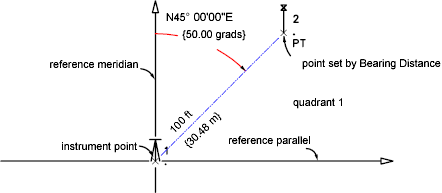Use the quadrant bearing and distance command (BD) to create an observation in reference to the occupied point using quadrant bearing and distance.
To create an observation using quadrant bearing and distance, using the command language
- In Toolspace, on the Survey tab, right-click the network that you want to add points to, and click Survey Command Window.
- At the Command line, enter:
BD (point) [quadrant bearing] [quadrant] [distance] (description)
To create an observation using quadrant bearing, distance, and vertical angle, using the command language
- In Toolspace, on the Survey tab, right-click the network that you want to add points to, and click Survey Command Window.
- At the Command line, enter:
BD VA (point) [quadrant bearing] [quadrant] [distance] [vertical angle] (description)
To create an observation using quadrant bearing, distance, vertical distance, using the command language
- In Toolspace, on the Survey tab, right-click the network that you want to add points to, and click Survey Command Window.
- At the Command line, enter:
BD VD (point) [quadrant bearing] [quadrant] [distance] [vertical distance] (description)
Examples
The following example illustrates using the BD command when the units are set to feet:
NE 1 100 100
STN 1
BD 2 45 1 100 TP
! QUADRANT BEARING: N 45-00-00 E DISTANCE: 100.0000
! POINT 2 NORTH: 170.7107 EAST: 170.7107
! LEVEL: <Null>
This creates point 2 at the quadrant bearing and distance specified.

Point created with the BD command:
Point 2 is located by turning a quadrant bearing of 45°0'0" (50 grads) in Quadrant 1 (NE) at a distance of 100 feet from the instrument point with the description TP.
Command Syntax
BD (point) [quadrant bearing] [quadrant] [distance] (description)
or
BD VA (point) [quadrant bearing] [quadrant] [distance] [vertical angle] (description)
or
BD VD (point) [quadrant bearing] [quadrant] [distance] [vertical distance] (description)
| Parameter | Definition |
|---|---|
| point | The point identifier of the new point. You do not need to assign a point number if auto point numbering is on. |
| quadrant bearing | The quadrant bearing. Enter this value in the current angular units (DMS, grads, decimal degrees, mils, or radians). |
| quadrant | The quadrant for the quadrant bearing. Specify the quadrant using one of the following numbers: 1 (for NE), 2 (for SE), 3 (for SW), or 4 (for NW). |
| distance | The distance from the instrument point to the point being located. It is measured in the current distance units. The distance is assumed to be a horizontal distance unless VA is used. When VA is used, the distance is recognized as a slope distance. |
| vertical angle | The direction of the vertical angle (zenith, horizontal, or nadir). Type this value in the current angular units (DMS, grads, decimal degrees, mils, or radians). |
| vertical distance | The level difference from the instrument to the prism. If the prism is higher than the instrument, then this is a positive value. |
| description | An optional description associated with the point. |